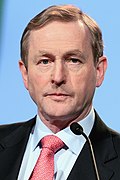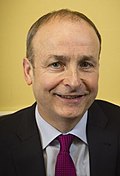2014_European_Parliament_election_in_Ireland
2014 European Parliament election in Ireland
Irish component of the 2014 European Parliament election
The 2014 European Parliament election in Ireland was the Irish component of the 2014 European Parliament election and was held on Friday, 23 May 2014, on the same day as the 2014 local elections and two by-elections (Dublin West and Longford–Westmeath).[2] The election was conducted under the single transferable vote. Counting of the votes began on Sunday, 25 May[3] and continued until Tuesday, 27 May.
| |||||||||||||||||||||||||||||||||||||||||||||||||||||||||||||||||||||||||||||||||||||||||||||||||||||
All 11 Irish seats to the European Parliament | |||||||||||||||||||||||||||||||||||||||||||||||||||||||||||||||||||||||||||||||||||||||||||||||||||||
|---|---|---|---|---|---|---|---|---|---|---|---|---|---|---|---|---|---|---|---|---|---|---|---|---|---|---|---|---|---|---|---|---|---|---|---|---|---|---|---|---|---|---|---|---|---|---|---|---|---|---|---|---|---|---|---|---|---|---|---|---|---|---|---|---|---|---|---|---|---|---|---|---|---|---|---|---|---|---|---|---|---|---|---|---|---|---|---|---|---|---|---|---|---|---|---|---|---|---|---|---|---|
| Turnout | 1,701,942 (52.4% | ||||||||||||||||||||||||||||||||||||||||||||||||||||||||||||||||||||||||||||||||||||||||||||||||||||
| |||||||||||||||||||||||||||||||||||||||||||||||||||||||||||||||||||||||||||||||||||||||||||||||||||||
 | |||||||||||||||||||||||||||||||||||||||||||||||||||||||||||||||||||||||||||||||||||||||||||||||||||||
In contrast to a poor local election result, Fine Gael retained 4 seats, remaining the largest Irish party at a European level. Despite winning the largest number of first preference votes, Fianna Fáil lost 2 seats – a result of poor candidate selection and a reduction in the number of seats. The Labour Party, bearing the brunt of voter anger with the Coalition government, suffered a meltdown, losing all three of its seats, including its seat in Dublin which it had held since 1989. The Socialist Party also lost its sole seat. The big winners were Sinn Féin and Independents who won three seats each.
In Dublin, Lynn Boylan of Sinn Féin topped the poll and a tight four-way battle for the remaining two seats ensued between Brian Hayes of Fine Gael, ex-Labour MEP turned independent Nessa Childers, Fianna Fáil's Mary Fitzpatrick and the Green Party's Eamon Ryan. Hayes and Childers won with Hayes ahead of Ryan at the final count by a margin of 1,200 votes.
In South, both Brian Crowley of Fianna Fáil and Seán Kelly of Fine Gael were re-elected while first time candidate Liadh Ní Riada of Sinn Féin won a seat. The last seat was taken by Fine Gael Senator Deirdre Clune ahead of her party colleague Simon Harris.
In the new Midlands–North-West constituency, independent TD Luke 'Ming' Flanagan topped the poll while Mairead McGuinness of Fine Gael and Sinn Féin's Matt Carthy took the next two seats. Fianna Fáil's two-candidate strategy in the constituency backfired, with sitting MEP Pat "the Cope" Gallagher narrowly losing to independent Marian Harkin. For the first time, Ireland's delegation to the European Parliament had more women than men.
The Constituency Commission made changes to the constituencies of Ireland so as to reduce the total number of MEPs from 12 to 11, due to the accession of Croatia to the European Union.[4]
The North-West and East constituencies were abolished. A new 4-seat constituency called Midlands–North-West was created. It comprised all the area of the previous North-West constituency, with the exception of County Clare which was moved to the South constituency; as well as the north Leinster part of the East constituency.[5]
The South constituency was increased in size by the addition of counties Carlow, Clare, Kilkenny, Wexford and Wicklow.[5] and the number of seats increased from 3 to 4.
There were no changes to the Dublin constituency.
| Party | Euro party | Euro group | Party Leader | Votes[nb 1] | % | +/– | Seats | +/– | |||
|---|---|---|---|---|---|---|---|---|---|---|---|
| Fine Gael | EPP | EPP | Enda Kenny | 369,120 | 22.3 | 6.8 |
4 / 11 |
||||
| Sinn Féin | None | GUE/NGL | Gerry Adams | 323,300 | 19.5 | 8.3 |
3 / 11 |
3 | |||
| Fianna Fáil | ALDE | ALDE | Micheál Martin | 369,545 | 22.3 | 1.8 |
1 / 11 |
2 | |||
| Labour Party | PES | S&D | Eamon Gilmore | 88,229 | 5.3 | 8.6 |
0 / 11 |
3 | |||
| Green Party | EGP | G–EFA | Eamon Ryan | 81,458 | 4.9 | 3 |
0 / 11 |
||||
| Socialist Party | EACL | GUE/NGL | Collective leadership | 29,953 | 1.8 | 0.9 |
0 / 11 |
1 | |||
| Direct Democracy Ireland | None | None | Jan Van de Ven | 24,093 | 1.5 | new | 0 / 11 |
||||
| People Before Profit Alliance | EACL | GUE/NGL | None | 23,875 | 1.5 | new | 0 / 11 |
||||
| Catholic Democrats | None | None | Nora Bennis | 13,569 | 0.8 | new | 0 / 11 |
||||
| Fís Nua | None | None | None | 4,610 | 0.3 | new | 0 / 11 |
||||
| Independent | 328,766 | 19.8 | 8.3 |
3 / 11 |
2 | ||||||
| Valid votes | 1,656,518 | 97.3 | |||||||||
| Blank and invalid votes | 45,424 | 2.7 | |||||||||
| Totals | 1,701,942 | 100.0 | — | 11 / 11 |
1 | ||||||
| Electorate (eligible voters) and voter turnout | 3,245,348 | 52.4 | 6.2 |
||||||||
| Source: ElectionsIreland.org | |||||||||||
- First preference votes: Under Ireland's STV (Single transferable vote) voting system, voters number candidates in order of their preference, from Number 1 upwards. The candidate who is given a Number 1 by the voter is said to have received his (or her) first preference vote.
Post-Poll Alliance
Voting details
| Constituency | Electorate | Turnout | Spoilt | Valid Poll | Quota | Seats | Electorate per Seat | Candidates |
|---|---|---|---|---|---|---|---|---|
| Dublin | 820,668 | 358,943 | 6,368 | 352,575 | 88,144 | 3 | 273,556 | 12 |
| Midlands–North-West | 1,202,997 | 663,703 | 17,258 | 646,445 | 129,290 | 4 | 300,749 | 14 |
| South | 1,221,683 | 679,296 | 21,798 | 657,498 | 131,500 | 4 | 305,420 | 15 |
| Total | 3,245,348 | 1,701,942 | 45,424 | 1,656,518 | — | 11 | 31 |
Candidate polling
Dublin
| Date | Polling agency | Sample size | Boylan (SF) | Hayes (FG) | Childers (Ind) | Fitzpatrick (FF) | Costello (Lab) | Ryan (GP) | Smith (PBPA) | Murphy (SP) | Tallon (Ind) | Darcy (DDI) | Whitehead (DDI) | Wise (FN) |
|---|---|---|---|---|---|---|---|---|---|---|---|---|---|---|
| 26–28 April | MillwardBrown/Sunday Independent[6] | 500 | 20% | 15% | 19% | 13% | 12% | 11% | 5% | 4% | – | 1% | – | – |
| 1–2 May | RedC/Sunday Business Post[7] | 500 | 15% | 18% | 10% | 13% | 13% | 12% | 9% | 7% | 2% | 1% | 1% | 0% |
| 13–14 May | MillwardBrown/Sunday Independent[8] | 500 | 23% | 22% | 13% | 11% | 10% | 7% | 6% | 7% | – | 1% | – | – |
| 3–15 May | Behaviour & Attitudes/Sunday Times[9] | 500 | 19% | 16% | 11% | 12% | 7% | 11% | 10% | 9% | 3% | 0% | 1% | 1% |
| 23 May | Behaviour & Attitudes/RTÉ Exit Poll[10] | 1000 | 24% | 14% | 11% | 12% | 8% | 14% | 6% | 7% | 1% | 1% | 1% | 0% |
Midlands–North-West
| Date | Polling agency | Sample size | Carthy (SF) | Byrne (FF) | Flanagan (Ind) | Gallagher (FF) | Harkin (Ind) | Higgins J. (FG) | McGuinness (FG) | Higgins L. (Lab) | Mullen (Ind) | Dearey (GP) | Fitzsimons (Ind) | Gilroy (DDI) | Nic Fhearra (FN) | Fay (Ind) |
|---|---|---|---|---|---|---|---|---|---|---|---|---|---|---|---|---|
| 26–28 April | MillwardBrown/Sunday Independent[6] | 500 | 17% | 16% | 12% | 9% | 12% | 11% | 11% | 4% | 3% | 2% | 3% | 1% | – | – |
| 1–2 May | RedC/Sunday Business Post[7] | 500 | 14% | 8% | 14% | 9% | 16% | 10% | 16% | 5% | 6% | 2% | 0% | 0% | 0% | – |
| 13–14 May | MillwardBrown/Irish Independent[11] | 500 | 19% | 9% | 15% | 10% | 12% | 6% | 13% | 5% | 5% | 3% | 1% | 1% | 0% | 0% |
| 3–15 May | Behaviour & Attitudes/Sunday Times[12] | 500 | 14% | 9% | 17% | 8% | 12% | 7% | 21% | 5% | 5% | 1% | 0% | 1% | 0% | 0% |
| 23 May | Behaviour & Attitudes/RTÉ Exit Poll[10] | 1000 | 13% | 10% | 20% | 11% | 11% | 7% | 16% | 4% | 4% | 2% | 0% | 1% | 0% | 1% |
South
| Date | Polling agency | Sample size | Crowley (FF) | Ní Riada (SF) | Kelly (FG) | Clune (FG) | Harris (FG) | Prendergast (Lab) | O'Flynn (Ind) | Godsil (Ind) | Hartley (FF) | O'Sullivan (GP) | Van De Ven (DDI) | O'Riordan (FN) | Cahill (Ind) | Heaney (CD) |
|---|---|---|---|---|---|---|---|---|---|---|---|---|---|---|---|---|
| 26–28 April | MillwardBrown/Sunday Independent[13] | 500 | 36% | 15% | 12% | 12% | 7% | 4% | 7% | 3% | 2% | 1% | 1% | – | 0% | 0% |
| 1–2 May | RedC/Sunday Business Post[7] | 500 | 28% | 14% | 18% | 8% | 7% | 9% | 4% | 3% | 3% | 6% | 1% | 0% | – | – |
| 13–14 May | MillwardBrown/Irish Independent[11] | 500 | 32% | 16% | 15% | 10% | 9% | 6% | 4% | 2% | 2% | 4% | 0% | 0% | 0% | 0% |
| 3–15 May | Behaviour & Attitudes/Sunday Times[12] | 500 | 35% | 14% | 17% | 10% | 8% | 5% | 2% | 2% | 1% | 3% | 1% | 0% | 2% | 1% |
| 23 May | Behaviour & Attitudes/RTÉ Exit Poll[10] | 1000 | 26% | 17% | 12% | 9% | 7% | 5% | 5% | 1% | 5% | 5% | 1% | 1% | 3% | 1% |
Party polling
The figures are for first-preference votes, as STV is a ranked voting system.
Dublin
| Date | Source | Polling agency | Fine Gael | Labour | Fianna Fáil | Sinn Féin | Socialist | Green | PBP | Others |
|---|---|---|---|---|---|---|---|---|---|---|
| 28 April 2014 | Sunday Independent[14] | MillwardBrown | 15% | 12% | 13% | 20% | 4% | 11% | 5% | 20% |
| 2 May 2014 | Sunday Business Post[15] | RedC | 18% | 13% | 13% | 15% | 7% | 12% | 9% | 14% |
| 14 May 2014 | Sunday Independent[8] | MillwardBrown | 22% | 10% | 11% | 23% | 7% | 7% | 6% | 14% |
| 14 May 2014 | The Sunday Times[16] | Behaviour & Attitudes | 16% | 7% | 12% | 19% | 9% | 11% | 10% | 16% |
Midlands–North-West
| Date | Source | Polling agency | Fine Gael | Labour | Fianna Fáil | Sinn Féin | Green | Others |
|---|---|---|---|---|---|---|---|---|
| 28 April 2014 | Sunday Independent[17] | MillwardBrown | 22% | 4% | 25% | 17% | 2% | 30% |
| 2 May 2014 | Sunday Business Post[15] | RedC | 26% | 5% | 17% | 14% | 2% | 36% |
| 14 May 2014 | Sunday Independent[18] | MillwardBrown | 19% | 5% | 19% | 19% | 3% | 34% |
| 14 May 2014 | The Sunday Times[16] | Behaviour & Attitudes | 28% | 5% | 17% | 14% | 4% | 35% |
South
| Date | Source | Polling agency | Fine Gael | Labour | Fianna Fáil | Sinn Féin | Green | Others |
|---|---|---|---|---|---|---|---|---|
| 28 April 2014 | Sunday Independent[17] | MillwardBrown | 30% | 4% | 39% | 15% | 1% | 11% |
| 2 May 2014 | Sunday Business Post[15] | RedC | 33% | 9% | 31% | 14% | 6% | 8% |
| 14 May 2014 | Sunday Independent[18] | MillwardBrown | 34% | 6% | 34% | 16% | 4% | 6% |
| 14 May 2014 | The Sunday Times[16] | Behaviour & Attitudes | 35% | 5% | 36% | 14% | 3% | 8% |
- Note that parties (other than independents) are initially ordered by number of seats won, followed by number of first preference votes [nb 1] if number of seats won is the same. Here Fine Gael and Sinn Féin are shown ahead of Fianna Fáil, who got more first preference votes, but won fewer seats.
- Popular vote means First preference votes. [nb 1]
- "Results of the 2014 European elections - Results by country - Ireland - European Parliament". Results of the 2014 European elections - Results by country - Ireland - European Parliament.
- "Local and European elections to be held on 23 May". Raidió Teilifís Éireann. 22 January 2014. Retrieved 22 January 2014.
- "Voter turnout of close to 50% reported in some areas". RTÉ News. 23 May 2014. Retrieved 23 May 2014.
- "New Irish MEP constituencies announced". RTÉ News. 25 September 2013. Retrieved 25 September 2013.
- "Report on European Parliament Constituencies 2013" (PDF). Constituency Commission. 25 September 2013. Retrieved 25 September 2013.
- Sunday Times/Behaviour & Attitudes European Elections Archived 19 May 2014 at the Wayback Machine Behaviour & Attitudes, May 2014.
- Fionnan Sheehan; Niall O'Connor (17 May 2014). "Flanagan on Course to Win Seat as Martin faces Key Test". Irish Independent.
- "Poll suggests SF & Independents' support has increased". RTÉ News. 17 May 2014. Retrieved 17 May 2014.
- "Hayes faces defeat in European elections, poll shows". Irish Independent. 27 April 2014. Retrieved 29 April 2014.
- "SF on course for Euro election victories but FG's Kelly faces defeat". Irish Independent. 26 April 2014. Retrieved 29 April 2014.





